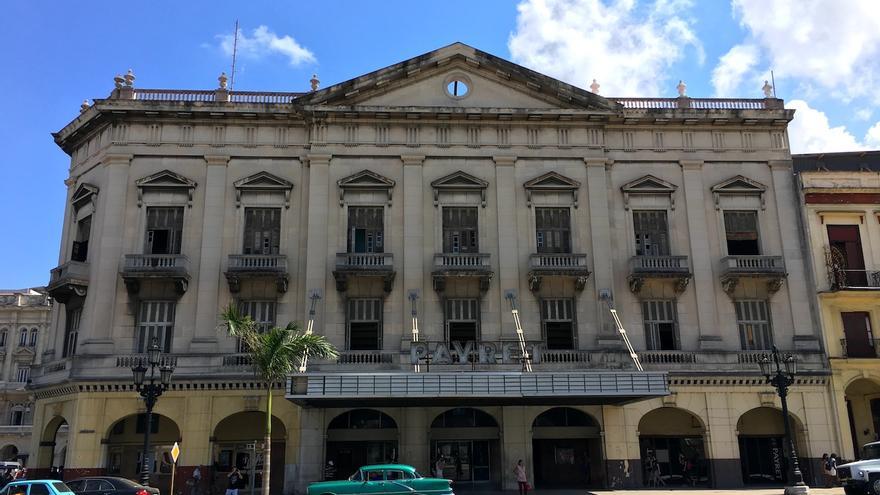
![]() 14ymedio, Luz Escobar, Havana, 15 January 2019 — “The Payret will continue to be a cinema for Cubans,” Eusebio Leal told the official cultural website La Jiribilla. Leal, Historian of Havana, wanted to settle the controversy over the fate of the old theater theater by confirming the construction of a hotel in the same block without affecting, according to his statements, the integrity of the theater-cinema.
14ymedio, Luz Escobar, Havana, 15 January 2019 — “The Payret will continue to be a cinema for Cubans,” Eusebio Leal told the official cultural website La Jiribilla. Leal, Historian of Havana, wanted to settle the controversy over the fate of the old theater theater by confirming the construction of a hotel in the same block without affecting, according to his statements, the integrity of the theater-cinema.
“With regards to the Payret hotel, which will actually be built on that block, I declare that this will not affect the integrity of the theater-cinema at all, but rather contribute to its restoration and the reopening of it as it has always been, a public service institution,” he said.
Leal has insisted that the construction of the Manzana Payret tourist complex and the Pasaje hotel, which is part of the works commemorating the 500th anniversary of the city in 2019, will not result in an increase in theater prices.
“The maximum ticket prices will not exceed the value that is paid today for accessing similar facilities such as the Martí Theater and the Nacional de Cuba,” the Historian said in the interview.
“Recently there’s been bad faith, an unwarranted suspicion, about the future of the Payret, that ignores, first of all, the attention this venue received throughout the Revolutionary period, an era during which two very expensive restorations have been undertaken,” protests Leal.
The controversy over the fate of the Payret as a cinema began in early December when the independent newspaper Cubanet published an article warning of the possible consequences of the remodeling of the entire block where the movie theater is located.
For several weeks, writers, artists and representatives of civil society criticized the supposed decision to turn the cinema into a hotel. One of them was the singer Haydée Milanés, who published a post on her Facebook account where she emphatically urged putting a stop to the disappearance of Payret.
Also the playwright Norge Espinosa deplored the situation in his article The Things We Are About to Lose, published by Café Fuerte .
“An intelligent restorer is trained to understand that the new use of a property with heritage value (like the Payret) must also protect its history. It could be restored as a theater and that would at least alleviate the loss of other things around it,” Espinosa wrote.
Weeks later, the statements of the Director of Development of the Ministry of Tourism, José Reinaldo Daniel Alonso, fueled the controversy. The high official gave to understand that the decision depended on Tourism and, by omission, that the people in charge of Culture had little or nothing to say on the matter.
“It will be studied, it will be seen and decided, at the appropriate time, if the cinema stays or not,” he said in an interview in Cubadebate. The official said that there is “a lot of ignorance regarding these projects” pointing to the diverse opinions of concern expressed on social networks.
Built by the Catalan Joaquín Payret, in its moments of splendor the building was known as “the cathedral of Spanish cinema in Cuba.” Currently the cinema has been closed for several years and both its interior and its facade suffer a deterioration that increases daily. The marquee shows rust stains, the walls are blackened by soot and both the interior carpentry and the seating of the building have been destroyed and systematically looted.
In its almost century and a half of existence, the Payret has undergone numerous architectural adaptations and experienced times of clear decline, but since the 1950s it has become one of the most iconic cinemas in Cuba. According to La Jiribilla, during the “revolutionary process” the building benefited from two restorations, one in 1969 and one in 1981, and the article added that the cinema-theater has remained closed since 2008 due to “functional deterioration and lack of constructive maintenance.”
The building is located just a few meters from the Kempinski Manzana Hotel. The numerous and frequent investments in luxury hotels contrast with the little concern for the abandoned cinemas of Havana, not to mention the critical situation in the housing sector and the scarce investment in residential buildings where thousands of people survive among the ruins caused by decades without being able to undertake a minimum restoration. Often these buildings suffer partial or total collapses leaving entire families homeless and some of these cave-ins have even resulted in the loss of human life.
_______________________
The 14ymedio team is committed to serious journalism that reflects the reality of deep Cuba. Thank you for joining us on this long road. We invite you to continue supporting us, but this time by becoming a member of 14ymedio. Together we can continue to transform journalism in Cuba.
